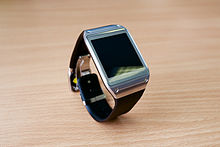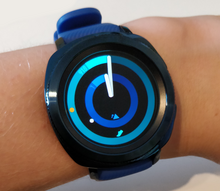Samsung Gear: Difference between revisions
mNo edit summary |
removed advertisement |
||
| Line 110: | Line 110: | ||
== References == |
== References == |
||
{{reflist}} |
|||
{{reflist}}9. [https://www.samsung-smartwatch.com Samsung SmartWatch] Shop for Samsung Smartwatch online at Best prices samsung All watches info{{Smartwatch}} |
|||
{{Smartwatch}} |
|||
{{Samsung Electronics}} |
{{Samsung Electronics}} |
||
Revision as of 15:00, 30 October 2019


Samsung Gear is a line of wearable computing devices produced by Samsung Electronics.
The first device in the series, the Samsung Galaxy Gear smartwatch, was announced in 2013.[1] Since then, the line has expanded to include fitness bands and earbuds, as well as more smartwatches.
In February 2019, Samsung announced a new smartwatch, new fitness bands, and new earbuds under the "Samsung Galaxy," rather than "Samsung Gear," brand,[2] thus potentially switching wearable products to that name.
Watches
Samsung Galaxy Gear
The Samsung Galaxy Gear is the first smartwatch in the Samsung Gear family. It was announced at a Samsung Unpacked event in Berlin, Germany on September 4, 2013, and was released on September 25, 2013. It was originally released with the Android operating system, but an upgrade to the Tizen operating system was later made available for the device.
- Display: 1.63" Super AMOLED display with 320x320 pixel resolution
- Storage: 4 GB
- RAM: 512 MB
Samsung Gear 2
Samsung announced the Samsung Gear 2 series, consisting of the Samsung Gear 2 and the Samsung Gear 2 Neo, on February 22, 2014. The Tizen-based smartwatches were released on April 11, 2014. The main differences between the two smartwatches are that the Gear 2 has a steel exterior and includes a camera, while the Gear 2 Neo is made from plastic and does not have a camera. The devices are the successors to the 2013 Samsung Galaxy Gear.
- Display: 1.63" Super AMOLED display with 320x320 pixel resolution
- Processor: Samsung Exynos 3250 Dual
- Storage: 4 GB
- RAM: 512 MB
Samsung Gear Live
Samsung and Google announced the Android Wear-based Samsung Gear Live smartwatch on June 25, 2014. The device was released the same day.
- Display: 1.63" Super AMOLED display with 320x320 pixel resolution
- Processor: Qualcomm Snapdragon 400
- Storage: 4 GB
- RAM: 512 MB
- Battery: 300 mAH
Samsung Gear S
Samsung announced the Tizen-based Samsung Gear S smartwatch on August 28, 2014, prior to its release on November 7, 2014. The device is the successor to the Samsung Gear 2 line.
- Display: 2.0" curved Super AMOLED display with 360x480 pixel resolution
- Processor: Qualcomm Snapdragon 400
- Storage: 4 GB
- RAM: 512 MB
- Battery: 300 mAH
Samsung Gear S2
The Samsung Gear S2 was released on October 2, 2015 and runs the Tizen operating system. The Gear S2 lineup consists of the Gear S2 and the Gear S2 Classic.
- Display: 1.2" circular Super AMOLED display with 360x360 pixel resolution
- Storage: 4 GB
- RAM: 512 MB
Samsung Gear S3
Samsung announced the Gear S3 line, which consists of the Gear S3 Classic and the Gear S3 Frontier, on August 31, 2016, ahead of its release on November 18, 2016. Both watches run the Tizen operating system, have IP68 water resistance, GPS, and heart rate monitor sensors.
- Display: 1.3" circular Super AMOLED display with 360x360 pixel resolution
- Processor: Samsung Exynos 7270
- Storage: 4 GB
- RAM: 768 MB
- Battery: 380 mAH
Samsung Gear Sport
Samsung announced the Samsung Gear Sport in August 2017 before its release on October 27, 2017.[3]
- Display: 1.2" circular Super AMOLED display with 360x360 pixel resolution
- Processor: Samsung Exynos 7270 Dual
- Storage: 4 GB
- RAM: 768 MB
- Battery: 300 mAH
- Colors: Black or Blue[4]
Fitness bands
Samsung Gear Fit
The Samsung Gear Fit fitness wristband was released on April 11, 2014 and runs a custom RTOS (real-time operating system).
- Display: 1.84" curved Super AMOLED display with 432x128 pixel resolution
- Storage: 4 GB[5]
- Battery: 210 mAH
Samsung Gear Fit 2
Samsung released the Tizen-based Samsung Gear Fit 2 fitness wristband on June 2, 2016 as the successor to the 2014 Samsung Gear Fit.
- Display: 1.5" curved Super AMOLED display with 432x216 pixel resolution
- Storage: 4 GB
- RAM: 512 MB[6]
- Battery: 200 mAH
Samsung Gear Fit2 Pro
Samsung announced the Samsung Gear Fit2 Pro along with the Samsung Gear Sport in August 2017.[7]
Earbuds
Samsung Gear IconX
Samsung launched the first-generation Gear IconX on 15 July 2016. It came in three colors (black, blue, and white) was promoted as having an internal storage "large enough for up to 1,000 MP3s."[8]
Samsung Gear IconX (2018)
Samsung announced the 2018 version of the Gear IconX in August 2017, along with the Gear Sport and the Gear Fit2 Pro. The Gear IconX (2018) features a much larger battery than its predecessor.[7]
Samsung Galaxy Buds (2019)
Samsung announced the third generation of their truly wireless earbuds in February 2019, along with the Samsung Galaxy S10 devices. The Galaxy Buds feature an updated design and a larger battery than its predecessor.[9]
Other devices
- Samsung Gear VR – Virtual reality device
- Samsung Gear 360 – 360-degree video camera
- Samsung Gear Circle – Smart neck band
References
- ^ "Samsung unveils Galaxy Gear smartwatch with 1.63-inch AMOLED touchscreen, built-in camera, 70 apps". Engadget. Retrieved 9 December 2013.
- ^ "Samsung Announces New Galaxy Watch Active, Galaxy Fit, and Galaxy Buds". Droid Life. Droid Life. 2019-02-20.
- ^ "Samsung Gear Sport". GSMArena.com. CDN by MAXCDN. Retrieved 13 January 2018.
- ^ "Gear Sport". Samsung. Samsung Electronics Co., LTD. Retrieved 18 March 2018.
- ^ "Samsung Gear review". Engadget. Retrieved 14 January 2018.
- ^ "Samsung Gear Fit2". Retrieved 14 January 2018.
- ^ a b Savov, Vlad (2017-08-30). "Samsung launches swim-tracking Gear Fit2 Pro and upgrades Gear IconX battery life". The Verge. Vox Media, Inc. Retrieved 28 January 2018.
- ^ "Samsung Gear IconX, Cord-Free Earbuds Hit the Shelves Today". Samsung Newsroom. Samsung. Retrieved 28 January 2018.
- ^ Cite error: The named reference
theverge_18229603was invoked but never defined (see the help page).
